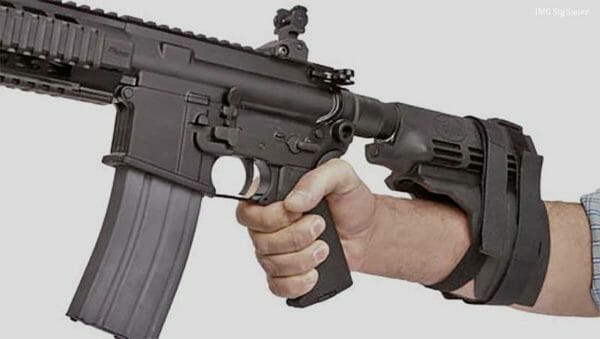
WASHINGTON, D.C. –-(Ammoland.com)- AmmoLand News has obtained a report dated February 12th, 2021 sent by the Congressional Research Service to Congress members about pistol braces. (embedded below)
Congressional Research Service (CRS) is a non-partisan government think tank that works with Congressional members on reports about different issues. The service consists of 600 government employees, including lawyers, economists, reference librarians, and social, natural, and physical scientists. It is the policy counterpart to the Congressional Budget Office (CBO).
William J. Krouse, Specialist in Domestic Security and Crime Policy, #ad wrote the report for members of Congress detailing the ATF’s long saga with stabilizing braces. This report can be a sign that Congress is once again looking into the brace issue. The CRS confidentially works with members of Congress, so AmmoLand News hasn’t been able to determine what member requested the document.
The document starts by Krouse summarizing the December 18th, 2020 pistol brace guidance letter submitted by the Bureau of Alcohol, Tobacco, Firearms, and Explosives (ATF) to the National Register. In his determination, the ATF was “preparing to reclassify certain heavier, larger handguns (pistols) equipped with stabilizing braces as more stringently regulated short-barreled rifles.” On December 23rd, he notes that the ATF “withdrew its guidance, pending further Department of Justice review.”
Krouse explains how a pistol brace helps a disabled shooter use an AR/AK-type pistol. He describes how the user would attach the stabilizing brace to their gun and how an operator would strap the pistol brace around their forearm. The specialist explains that the first model was to help a disabled veteran safely use his firearm. From his description, Krouse studied the history of pistol braces.
Krouse then goes onto say that shooters can use stabilizing braces and similar devices as a “quasi-shoulder stock.” He states in his opinion that by adding a stock to certain pistols, the user could change a firearm’s classification under the Nation Firearms Act of 1934 (NFA) and the Gun Control Act of 1968 (GCA), effectively turning the gun into a short-barreled rifle (SBR) or a short-barreled shotgun (SBS).
The specialist points out that the ATF has long held “that the attachment of a shoulder stock to a handgun or pistol grip firearm transformed that GCA-regulated firearm into an NFA-regulated short-barreled rifle or shotgun.”
Krouse points also out that in November of 2012, the ATF ruled that a user installing a stabilizing brace would not be enough to change the firearm classification.
Krouse then speaks about the ATF’s 2015 open letter, which seemed to insinuate that a shooter could not shoulder a firearm with a brace installed. He mentioned several private letters that the agency issued that walked back these statements. Although in 2018, the government charged an individual with possession of an unregistered SBR because his AR-pistol had a cheek rest installed and its “length of pull” was greater than 13.5 inches. The defendant beat the charges because of the “ATF’s failure to take the measurement properly in alignment with the barrel’s axis.” Krouse echoed what the industry has been saying for years.
He states: “This case is an example of how the absence of definitive determinations about the legality of firearms equipped with stabilizing braces and similar devices may create repercussions.”
He then explains different NFA items and gives an overall review of firearms, such as what constitutes a shotgun and what constitutes a smooth bore pistol. He explains the differences between GCA-controlled firearms and NFA-controlled firearms. Krouse also breaks down other firearms laws that surround both.
Krouse discusses a potential gray area in the law. He mentions how “some GCA-regulated handguns and pistol grip firearms are dimensionally equivalent—in terms of their barrel lengths, overall lengths, and/or barrel bores—to other NFA-regulated firearms.” He explains by modifying the barrel length of a rifle or shotgun, a user could change the classification of the firearm. He points out that if a pistol never had a stock attached that a user could not turn the gun into an SBR or SBS under the NFA.
Krouse mentions companies successfully marketing AR and AK-type pistols #ad since the sunsetting of the Clinton era “assault weapons” ban. He notes that many of the guns that companies are selling would have been illegal under the expired law. However, AmmoLand News is unsure as to why he stated that fact in this document.
10 To 40 Million Pistols Equipped With Stabilizing Braces
He then discusses how the sale of these firearms has exploded in the past 12 years. He theorizes the rise of these guns is due to pistol braces. The government unofficially believes that there are 10 to 40 million pistols equipped with stabilizing braces in the country. This number is higher than previously thought.
The document ends with the firearms rights advocate’s view that stabilizing braces are a viable alternative to creating an NFA firearm. He also points out that anti-gun advocates want to see the ATF reverse course on its brace rulings and have called on Congress to act.
The document is a valuable insight into the information that the CRS is providing Congress on gun issues.
Congressional Research Service Issues Report on Stabilizing Braces for Congress
About John Crump
John is a NRA instructor and a constitutional activist. John has written about firearms, interviewed people of all walks of life, and on the Constitution. John lives in Northern Virginia with his wife and sons and can be followed on Twitter at @crumpyss, or at www.crumpy.com.

The post Leaked: Congressional Research Service Report on Firearms Stabilizing Braces appeared first on AmmoLand.com.
from https://ift.tt/3u926AV
via IFTTT

No comments:
Post a Comment